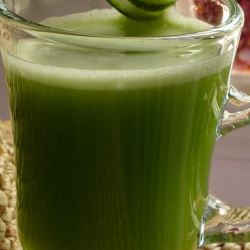How did drinking a large glass of expensive celery juice every morning become the latest health fad? It beats us.

If you have more money than sense, how about spending $129.99 every 18 days on fresh celery juice delivered to your door?
As mad as it sounds, some people are willingly handing over this amount of cash to invest in an unpleasant tasting juice that, truth be told, isn’t especially nutritious.
Marketeers know that being more expensive than the competition can give you the upper hand (because people assume your product must be superior), but celery juice companies are taking this concept to a whole new level.
What’s more, many of the claims being made for celery juice are off-the-scale bonkers, not to mention in contravention of every food advertising regulation going.
On amazon.com, Raw Generation proclaims that their celery juice goes ‘beyond just a regular detox’, and that you can expect to see ‘weight loss, clearer skin, improved gut health and overall better mental clarity’. The juice is also said to be ‘great for boosting energy, helping you tackle your daily challenges’.
Although this is over-hyped nonsense, it’s tame compared with the stuff spouted by Anthony William, aka ‘the medical medium’ who is credited with starting the celery juice craze that has swept both west and east coasts. The #1 New York Times best-selling author not only labels celery juice ‘a powerful and miraculous healing remedy’, but also claims to converse with the ‘Spirit of Compassion’, who allegedly provides him with ‘extraordinarily accurate health information that's far ahead of its time’.
Er, OK then. (Perhaps not surprisingly Gwyneth Paltrow considers Anthony William a trusted expert, and she has him write for Goop.com).
But as stupid as daft food scams are, there’s usually at least some remote, tenuous, connection with a nutritional truth, however much distorted.
In the case of celery, the ‘truth’ is hard to find, because compared head to head with pretty much any other vegetable, celery actually fairs pretty poorly in the nutritional stakes.
As an example, just see how celery stacks up against broccoli, kale and romaine lettuce. You’ll see it scores lower across the board in a wide range of vitamins and minerals.
|
Per 100g*
|
Celery |
Broccoli |
Kale |
Romaine lettuce |
|
Energy |
16kcals |
34kcals |
49kcals |
19kcals |
|
Fiber** |
1.6g |
2.6g |
3.6g |
3.1g |
|
Sugars |
1.34g |
1.7g |
2.26g |
0.71g |
|
Calcium |
40mg |
47mg |
160mg |
62mg |
|
Iron |
0.2mg |
0.73mg |
1.47mg |
0.9mg |
|
Magnesium |
11mg |
21mg |
47mg |
20mg |
|
Potassium |
260mg |
316mg |
491mg |
327mg |
|
Vitamin C |
3.1mg |
89.2mg |
120mg |
11.5mg |
|
Folate |
36µg |
63µg |
141µg |
129µg |
|
Beta carotene |
0.27mg |
0.36mg |
5.9mg |
3.3mg |
|
Vitamin E |
0.27mg |
0.78mg |
1.54mg |
0.94mg |
|
Vitamin K |
29.3µg |
102µg |
705µg |
210µg |
*Source: USDA
**The fiber gets removed upon juicing
Away from the main micronutrients, celery, like parsley, is a rich source of the phytochemicals apigenin and luteolin (part of the flavonoid family), so it’s not a total nutritional dunce.
Luteolin has been explored as a neuroprotective agent in preclinical models and has also shown antioxidant, anti-cancer an anti-inflammatory effects in vitro. Similarly, apigenin has theoretical anti-inflammatory and anti-tumor properties.
However there’s no research to support any specific health benefit of these two flavonoids in humans and certainly nothing to support the notion that you must obsessively juice a whole stalk of celery every day to achieve some higher plane of wellness.
In fact, juicing has the disadvantage of removing the fiber from fruit and vegetables, so if and when you do have a yearning for celery it’s better to chomp on whole celery sticks than to juice them.
You might even serve celery sticks with some salsa or hummus so you get a nice-tasting snack, which juiced celery definitely isn’t.
And by not falling for the celery juice fad, you won’t get left with a doubly sour taste from being totally ripped off.
